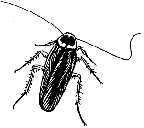
| 
|
Most cockroaches are tropical or sub-tropical in origin and generally live outdoors. However, some species do live indoors. It is true that they thrive in dirt, trash and grime, but cockroaches can infest even clean and well-organized homes and buildings.
In Texas, only five species of cockroaches ar really troublesome indoors; others live outdoors. Depending on species, cockroaches can be golden-brown, reddish-brown, lightbrown, glossy or very darkbrown, or black in color, and range from 1 /2-inch to1 3 /4-inches long.
Where do cockroaches live?Most cockroaches come out only at night but may appear during the day when disturbed or where there is a heavy infestation. They prefer warm, dark, humid shelters like the kitchen sink or drain board; cracks around cabinets; window or door frames; loose baseboards or molding strips; upholstered furniture; bathrooms; and motor compartments of refrigerators, washing machines and other appliances. Know where cockroaches hide because these are the locations you must treat.
Cockroaches eat different plant and animal products, including meat and grease, starchy foods, sweets, baked goods and other unprotected kitchen goods. They also feed on materials such as leather, book binding and sizing, and wallpaper paste.
How to control cockroaches
Most
of these are fairly inexpensive:
|
Inspect regularly and thoroughly to locate conditions which invite cockroach invasions. Examine all known or suspected cockroach hiding places and incoming materials.
Sanitation
Good sanitation, both indoors and outdoors, effectively limits
cockroach populations. Do not leave unwashed dishes, kitchen
utensils and uncovered food out overnight. Clean up all spilled
liquids. Clean areas beneath cabinets, furniture, sinks, stoves
and storage bins where tiny particles of food may accumulate.
Keep kitchen garbage and excess trash in container sand remove
them regularly. Store dry pet food away from the kitchen and
other foods. If you feed pets indoors, remove the leftover
foods immediately. Clean outdoor garbage cans frequently,
along with platforms or slabs on which they are kept.
Seal any cracks of 1 /8 inch or more in the foundation and exterior walls. Check the caulking around air conditioning units, windows, doors, pipes or other openings into the home. Repair cracks and holes in floors, walls and ceilings. Seal openings around plumbing fixtures, furnace flues, electrical outlets, windowsills and walls, and along baseboards and ceiling moldings. Repair leaky water faucets and pipes.
Eliminate hiding placesKeep yard trash and stacks of firewood away from your home or garage to minimize the chance of cockroach invasion. Paper, cardboard, lumber and firewood in the home provide excellent refuge for cockroaches.
Cockroach trapsTrapping can reveal the hiding places and the seriousness of the infestation. Trapping alone will not eliminate cockroaches, but should be used with preventive measures for better results. Many inexpensive cockroach traps are available. They are easy to use, disposable and contain no toxic insecticide. Most are box shaped and coated with a very sticky adhesive inside. Some traps may also feature slow release food attractant. Cockroaches enter the trap when detecting the food odor and stick to the adhesive. Place traps where cockroaches are likely to travel. Change the trap's position if no cockroaches are caught after two or three nights.The number of traps required will depend on the kind of cockroach present and location of the infestation.
Chemical controlFor more information about treating your home for severe infestations, contact your local county Extension office.
|
Texas
Agricultural Extension Service · The Texas A&M
University System |
Adapted from TAEX publication L-1458 Cockroaches . . .Recognition and Control for your use by Ana A. DeLuna, Extension Assistant in Communications. Graphic design by Rhonda R. Kappler.
Educational programs conducted by the Texas Agricultural Extension Service serve people of all ages regardless of socioeconomic level, race, color, sex, religion, handicap, or national origin.
Disclaimer and Reproduction Information: Information in NASD does not represent NIOSH policy. Information included in NASD appears by permission of the author and/or copyright holder. More